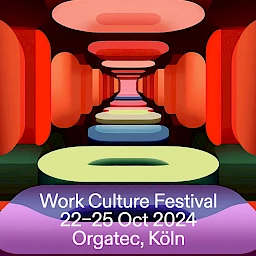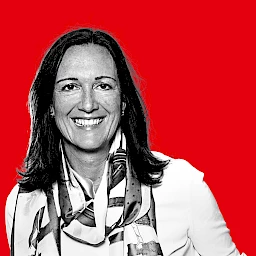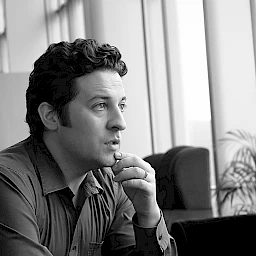Our environment is already influencing our work performance. AI is transforming offices into sensitive habitats where digital and physical factors alike influence our mood, productivity and collaboration. The IBA Forum editorial team spoke with the UX expert Sophie Kleber about the advantages of intelligent environments and measures for ensuring harmonious interaction between technology and people.
Disclaimer: In this interview, Sophie is not speaking on behalf of Google or Alphabet. All opinions are her own and do not reflect Google’s or Alphabet’s position on any of the topics.
What does a UX designer do?
A UX designer (user experience designer) plays an important role in the development of successful products. The primary focus of the UX designer is on finding out what users really want. In short, UX designers are the representatives of users’ wishes and needs. In our work we take three different approaches: analysing user interaction, directly surveying users, and investigating unspoken requirements. First, we use the available data to analyse how users interact with a product, for example a website or an app. During this process we identify the places where they encounter difficulties or get stuck. We also listen closely to users and identify their problems and needs. For example, when an individual is buying a car the issue may be not so much the possession of a car as the need for a certain kind of mobility. The approach to investigating unspoken requirements needs intensive research. We visit members of target groups in their homes or workplaces in order to understand their environment and identify possible improvements that the users themselves may not be able to express. UX designers than work together with their colleagues from the areas of product management and engineering to translate all of these findings into a UX strategy that harmonises user needs with the company’s goals. Finally, we visualise the various user flows with the help of wireframes or mock-ups in order to gain a clear idea of how the end product should look and function.
What sparked your interest in the interface between technology and people, especially with regard to workplace design?
I find workplace design very interesting from a historical perspective. The concept of the open-plan office was born in the 1960s, and it looked very good on paper but was never really tested. No one ever focused on it really closely or said, you are more productive because you’re sitting here. All of it was conceptual work. I believe that it was the pandemic in particular that shook us up and showed us, especially in the area of knowledge work, that we should focus more closely on the topic of workplace design and productivity. The process of measuring productivity is often difficult and subjective. And you realise very quickly that the workplace we have accepted as a standard, especially in knowledge work, is not very conducive to productivity after all. For a long time we developed a workplace where you move to a different place if you’re switching tasks. In other words, I sit at my desk, which is intended only for doing “deep work”. If I have to attend a conference, I enter a meeting room or a telephone cubicle. During the pandemic, this situation changed completely. Employees have shown that they can do all of their work at their desks and that the workplace adapts itself to the way each individual works there. And now that we are working in hybrid models, the following question occurs to me: How could this kind of work environment be designed to function better for people now and in the future? That’s because this concept of everyone being in one place, coming to the office and then laying aside their pens at 4 o’clock or 6 o’clock – it no longer works. It is not global work. And when I use the term “workplace” I don’t mean just the workplace at the office but also the workplace at home. How does this function in the context of shared work and the fulfilment of user needs? And are there AI tools that can promote productivity and well-being – two things that are very closely connected – in the workplace?
Visit the Work Culture Festival from 22 to 25 October at ORGATEC in Cologne

How do you imagine AI could be integrated into physical workspaces, both at home and in the office? What are the most important trends that will change our work culture?
Today our work environment is still quite passive. Lights are not intuitively switched on and off; as a user, I have do this myself. If the temperature isn’t right, I have to go and change it myself. Whether people feel comfortable or not depends very much on how noisy, warm or cold their environment is. And these perceptions are very individual. I think that when we start to see what happens when a room can see and show us things, or when a room can hear and communicate, then we will start to think differently about how our work environment can be a partner. And when the passive temperature, the passive lighting and the passive ventilation can adapt itself to the individual, that will create a very interesting symbiosis and connection between an individual’s biorhythm and his or her environment. For example, if you were to say that the lighting changes in the course of a day – in other words, it’s brighter in the morning, somewhat darker toward noon and brighter once again in the afternoon – this can further increase productivity. In my opinion, these are the exciting ideas we need to work on, not only in the office but also in the individualized workspace. This would mean companies also going to their employees’ homes and asking them: How can I help you so that your workplace at home is also optimally equipped and reflects our corporate culture? How can I make sure that your equipment at home fulfils the same, or almost the same, ergonomic standards as your equipment in the office? And which of the things I’m trying to optimize for you in the office can I provide for you at home if you allow me to do so? However, I believe that companies have still not really understood that when employees can also work from home as a matter of course, this is connected with a certain amount of responsibility. Consequently, companies must also take an interest in the equipment of their employees’ home workplaces, and they must consider how they can enable the employees working from home to participate in the corporate culture. This might mean providing apples and snacks free of charge or designing spaces with plants, colours, aromas and so on. All of these elements amount to a subtle corporate culture.
Is this your vision of the future of human-machine interaction in the work environment – that technology recognizes whether an individual needs it slightly cooler, warmer or better lit? What developments do you expect to see in this area during the next five or ten years?
My vision consists of two stages. The first stage would be the question of how we can design our environment to adapt more effectively to its users. There are already some buildings and experiments, especially in Italy and the Netherlands, that focus on how one can collect and process this information. However, at the moment this information still has to be entered manually, because spatial intelligence still does not automatically understand whether an individual would like to have a cooler or a warmer environment. All of this is still a matter of input-output. We have to say whether the environment is too cold or too warm for us. However, in the long term I see the possibility of adapting the environment to human needs, either those of an individual or of a group. This adaptation is linked with a certain subtlety and passivity. The next step would be to make the environment an active part of the work process. For example, a room could automatically record the minutes of a meeting. Today AI can already transcribe conversations, and these notes can be edited later on. This could eliminate the need for a human being who records the minutes. The environment could also actively respond to the dynamics of a meeting by, for example, making the light more pleasant or piping more oxygen into the room if the discussion is faltering. Overall, in the years ahead I expect to see exciting experiments that may function or not, but will in any case change the prevailing corporate culture.
Is this the intelligent environment you will talk about in your keynote speech? And will you also discuss the effects of intelligent environments on productivity and well-being in the workplace?
Yes, that’s exactly what I’ll be talking about. Besides, in my keynote speech I will present prototypes that show what is already possible and how intelligent environments of this kind can promote well-being. My task as a UX designer is to always focus on human beings and understand what they really need and want. Although I work in the digital field, I also love the physical world and the feel of things. We are physical beings, and our natural condition is to be moving around in the physical world. The task and the goal is to design technology in such a way that it supports our natural condition and makes our life easier without replacing the physical world. In other words, to make our daily life more functional and more pleasant.
Now let’s talk about the critical aspects of technology. What are they, in your opinion?
There are two essential questions we have to face: How can we ensure that technology always has its sights on people’s well-being, and what ethical considerations are especially important in this connection? And users need to be able to decide for themselves whether they disclose their data or not. There should not be a default opt-in, especially not in a professional context. Users should always have the choice, without any negative consequences for their work experience. To take one example, in an intelligent building the users can decide whether or not they want to reveal their preferences regarding aspects such as temperature or lighting. If they decide not to do so, this may mean that they will sometimes have to manually regulate their environment, but they should be able to work productively nonetheless. Another problem is privacy. Although many people value privacy, in practice it is often outweighed by the desire for convenience. One example of that is people’s acceptance of biometric data for unblocking digital devices. Here it’s important for companies to deal ethically with data and to offer people clear, user-friendly options for controlling and denying access. For example, a small green light now appears on a smartphone display when the camera is active. Transparency measures such as this one are important. The standards are constantly shifting, and they keep on moving. Things that seem unacceptable today can already be accepted tomorrow if the benefits are apparent. In this connection I like to mention a pendulum, the pendulum of innovation. Some technologies move far ahead and offer a great deal, but the users may not want everything they’re offered and may therefore reject the technologies – and then the pendulum eventually rests in the middle.
A few years ago you said in an interview, “Technology will become like air. It’s everywhere. You breathe it in, you breathe it out. It’s around you, and it’s this connective tissue between the world and yourself.” (“Technology shouldn’t be right in front of our noses. We call it invisible tech or ubiquitous tech – the idea that everything is connected, but you don’t have to worry about it. The idea of voice being able to communicate with technology is really just the switch of being able to communicate on our own terms.”) How has your view of this changed with regard to AI?
The concept I had of this technology like air is that actually all of us have a kind of “self-cloud” around us. This cloud saves information about us such as our musical tastes, personal preferences and physical attributes. The idea was that this information can be flexibly revealed and retracted in order to adapt our environment gently and without a great deal of effort. At the moment, this kind of information still has to be input manually, and we have to actively communicate our preferences. But in my vision, this technology should function as intuitively and effortlessly as possible. And because of the development of AI lots of things have changed. Amazon’s Alexa was launched on the market ten years ago, and although we started to communicate with this technology in a human way, it involved new problems. For example, critics said that language assistants with a woman’s voice reacted inappropriately. Today, ten years later, we’re seeing similar problems with AI that behaves in a humanoid way. I believe that the idea that AI should take on human characteristics is unnecessary and even problematic. Technology should support us, but it doesn’t have to speak like a human being or behave like a human being. We have to move away from the idea that AI is a personified entity.
In the context of all this technological progress, which aspects do you believe are important for making sure the “human touch” is not lost in tomorrow’s world of work?
People should always be in the foreground, and technology should have a supportive effect. One central aspect is the fact that we must consciously decide what stays within the human realm and what we outsource. Technology should never replace human intuition and creativity; instead, it should supplement it. And a philosophical factor comes into play here as well. For example, we should ask ourselves whether we want AI to write e‑mails for us or whether we would prefer to communicate with other people ourselves. It’s important to decide for ourselves how we use technology without letting it take human interaction away from us. The world of work will change because of AI-controlled environments, and this will have positive as well as negative effects. One positive aspect is that AI as an assistant can take over administrative tasks, and that will enable us to work more efficiently. However, we have to be careful when it’s a matter of person-to-person communication. Technology should not prevent us from interacting on a personal level. AI should function as a “thought partner” rather than a “thought producer”. It can point out options, but the decisions should always still be made by human beings. Human beings have intuition and a comprehensive context that extends beyond things that can be digitalised. This human capability, as well as the ability to empathise and engage in creative problem-solving, are irreplaceable. That’s why we must consciously design the way we integrate technology in order to ensure that the “human touch” remains unchanged.
To conclude, I’m interested in a personal insight. How do you work? In other words, what does your “sentient workspace” look like?
In general, my workspace is a mixture of technology and personal rituals that help me to stay focused and productive without losing sight of the human factor. I’ve thought long and hard about this topic, especially during the pandemic, when I was looking out at a rear courtyard in Berlin. My sentient workspace has a lot in common with small personal adaptations that promote my sense of well-being. I believe in biophilic design, I take care of my plants, and I use an aromatherapy diffuser. The ritual of turning on the diffuser at least once a day helps me to switch into a different work mode or prepare for meetings. Moments like these have nothing to do with AI, and they are very important for me personally. For the sake of my physical well-being I’ve acquired a very adjustable chair that enables me to sit cross-legged or with my feet up – positions that I find relaxing. As regards AI, I’ve tried to use tools for writing my e‑mails, but the technology is not yet mature enough for that. E‑mails are a sensitive area, and I appreciate the human touch that AI cannot replace at the moment. That’s why I mainly use AI for visual tasks such as generating images for presentations. That saves time and it’s fun, even though it sometimes feels odd to shorten the traditional creative process.
Sophie, thank you for this interview.






